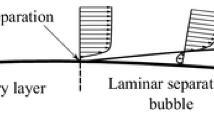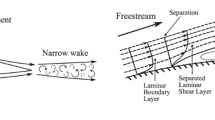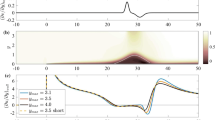Abstract
This paper investigates a large, laminar separation bubble that extends from near the leading edge and along the pressure surface of a low-pressure turbine blade. Whilst stability analyses are not performed, experiments suggest that the separation is convectively unstable at positive incidence. The separation then appears to exhibit absolute instability and, finally, global instability as the incidence of the blade becomes more negative. The conjectured onset of absolute and global instability is used to provide a possible explanation for the separation’s reduced sensitivity to ‘aircraft engine representative’ disturbances as the incidence of the blade becomes more negative.










Similar content being viewed by others
Abbreviations
- C :
-
chord (m)
- C X :
-
axial chord (m)
- C P =( P 01− P)/( P 01− P 2):
-
static pressure coefficient
- \( \bar{f} \)= fC / V 2 :
-
reduced (nondimensional wake passing) frequency
- h :
-
span (m)
- i :
-
incidence (°)
- P :
-
pressure (Pa)
- R :
-
reattachment point
- Re 2= V 2 C / ν :
-
cascade exit Reynolds number
- Re δ *= Vδ */ ν :
-
Reynolds number based on displacement thickness
- s :
-
blade pitch (m)
- s :
-
entropy (J/kg.K)
- S :
-
separation point
- T :
-
temperature (K)
- \( \bar{u} \) :
-
mean velocity (m/s)
- u RAW :
-
raw velocity (m/s)
- u RMS :
-
RMS velocity (m/s)
- V = V 2√ C P :
-
isentropic velocity (m/s)
- V REV :
-
reverse velocity (m/s)
- x :
-
axial direction (m)
- θ :
-
circumferential direction (rads)
- ζ S :
-
entropy coefficient
- 0:
-
stagnation
- 1:
-
cascade inlet
- 2:
-
cascade exit
- ∞:
-
freestream
References
Alam M, Sandham ND (2000) Direct numerical simulation of ‘short’ laminar separation bubbles with turbulent reattachment. J Fluid Mech 410:1–28
Bearman PW, Morel T (1983) Effect of free stream turbulence on the flow around bluff bodies. Prog Aero Sci 20:97–123
Brear MJ, Hodson HP, Harvey NW (2002a) Pressure surface separations in low pressure turbines. 1. Midspan flow. ASME J Turbo 124:393–401
Brear MJ, Hodson HP, Gonzales P, Harvey NW (2002b) Pressure surface separations in low pressure turbines. 2. Interactions with the secondary flow. ASME J Turbo 124:402–409
Dorney DJ, Flitan HC, Ashpis DE, Solomon WJ (2000) Effects of blade count on boundary layer development in a low-pressure turbine. AIAA paper 2000-0742
Dovgal AV, Kozlov VV, Michalke A (1996) Laminar boundary layer separation: instability and associated phenomena. Prog Aero Sci 30:61–94
Drela M, Youngren H (1995) A user’s guide to Mises 2.3. MIT Laboratory Computational Aerospace Science Laboratory report
Fiedler HE, Fernholz HH (1990) On management and control of turbulent shear flows. Prog Aero Sci 27:305–387
Giles M, Haimes R (1995) Unsflo user’s manual, version 6.0. MIT Laboratory report
Hammond DA, Redekopp LG (1998) Local and global instability properties of separation bubbles. Euro J Mech B Fluids 17:145–164
Hodson HP (1984) An inviscid blade-to-blade prediction of a wake-generated unsteady flow. ASME paper 84-GT-43
Horton HP (1969) A semi-empirical theory for the growth and bursting of laminar separation bubbles. ARC current papers, no 1073
Howell RJ, Ramesh ON, Hodson HP, Harvey NW, Schulte V (1999) High lift and aft loaded profiles for low pressure turbines. ASME paper 2000-GT-261
Kiya M, Sasaki K (1983) Structure of a turbulent separation bubble. J Fluid Mech 137:83–113
Niew TR (1993) The stability of the flow in a laminar separation bubble. Dissertation, University of Cambridge, UK
Watmuff JH (1999) Evolution of a wave packet into vortex loops in a laminar separation bubble. J Fluid Mech 397:119–169
Acknowledgements
The authors would like to thank Rolls-Royce plc and the Defence Evaluation and Research Agency (MOD and DTI CARAD) for their generous financial support.
Author information
Authors and Affiliations
Corresponding author
Rights and permissions
About this article
Cite this article
Brear, M.J., Hodson, H.P. The response of a laminar separation bubble to ‘aircraft engine representative’ freestream disturbances. Exp Fluids 35, 610–617 (2003). https://doi.org/10.1007/s00348-003-0709-7
Received:
Accepted:
Published:
Issue Date:
DOI: https://doi.org/10.1007/s00348-003-0709-7




